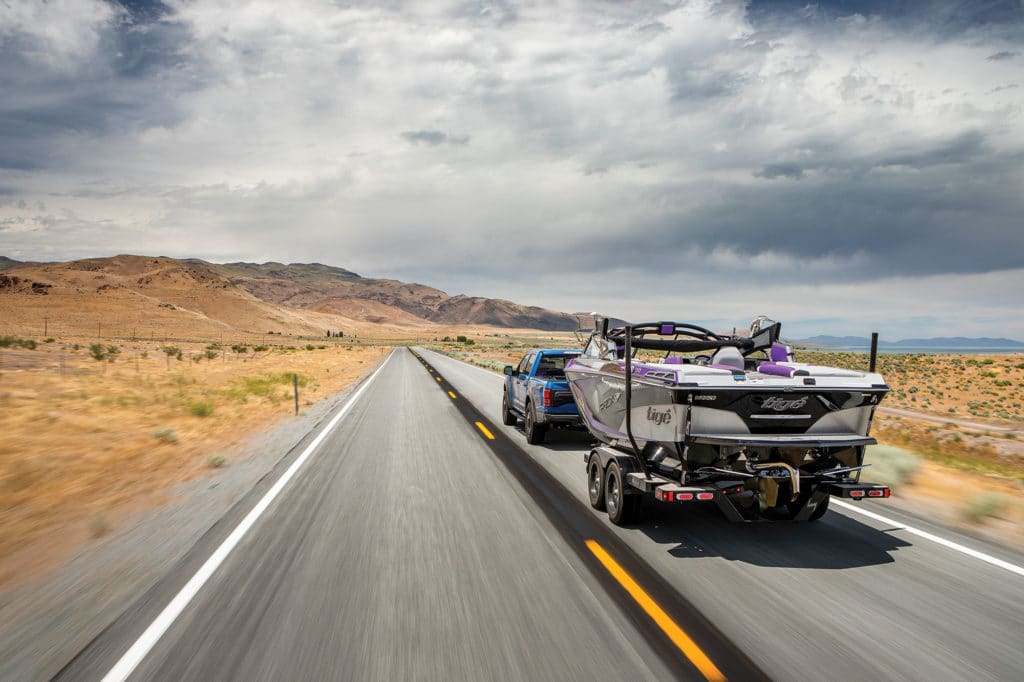
In my dreams, I’m in the middle of nowhere. In a boat. “In solitude lies solace,” said someone famous—possibly, once upon a time. And so, a longing for solitude, plus fatigue from the rat race of Los Angeles, drove me to pursue a favorite pastime: wakesurfing. But it had to be on a lake that is remote, glassy, deserted, and did I mention serene?
There is such a place. Nevada’s Pyramid Lake is an hour’s drive north of the state capital, Carson City, situated in the afternoon shadows of the Sierra Nevada. Owned by the Paiute tribe, Pyramid is as vast—nearly 190 square miles—as it is remote. Visually, it looks like a sky-blue body of water that’s been helicoptered into the center of Death Valley. Except for a few cottonwood groves and desert scrub, Pyramid is as barren a place as you’ll find—which is fine by me.
The lake’s desert environment and undeveloped lakeshore mean special opportunities—and some challenges—for boaters. While a concrete launch ramp and several acres of paved parking exist here, boaters yearning for solitude can launch from the dirt shoreline in various more-secluded places. As such, for someone interested in getting off the grid and away from the back beat of daily life, heading off-road seemed the way to go.
But how do you do that with a wakeboard boat? Thankfully, Ford and Tigé let us try. Ford chipped in a 2019 F-150 Raptor 4×4 SuperCrew powered by a high-output, twin-turbocharged 3.5-liter EcoBoost V-6 rated at 450 hp. Tigé provided a 20-foot 2019 RZX20 powered by Indmar’s 6.2-liter Raptor V-8, rated at 350 hp. The coincidence here is more than name: Indmar is Ford’s official marine engine partner, and the big Raptor V-8 in the Tigé boat is a derivative of Ford’s previous SVT Raptor truck V-8.
Leaving Town
The way out of LA is I-5, the long, hot interstate running the nearly 800-mile length of California. With its turbo power, 10-speed transmission, 8,000-pound tow rating, and comfortable heated and cooled seats, the Raptor proved a worthy tow rig for four adults and our gear. Fuel economy on the recommended 91-octane unleaded hovered just above 12 mpg for most of the trip, until after 490 miles, when we began climbing into the Sierras northeast of Sacramento. In that elevation, the rolling average dropped to 9.9 mpg.
Nightfall brought the soft, sweet smell of pines as we steered onto I-80 and climbed to 7,227 feet (1.4 miles high) to Donner Summit, north of Lake Tahoe, then we leveled off and began a gradual descent into Nevada’s Carson Valley. A key advantage for the twin-turbo Raptor V-6 is its comparable performance to a normally aspirated V-8, little loss of performance at altitude, and improved fuel economy in everyday city and highway driving. Our only substantive criticisms of the Raptor are its growling exhaust note and choppy ride quality, a function of the big -17-inch off-road wheels and tires, and firm suspension.
And as for the Tigé trailing behind, with the stout F-150 equipped with electronic sway control, it registered only moderately as a big load in tow, and the four-wheel disc surge brakes on the trailer did a fine job helping slow and stop the rig. Made by Boatmate, the trailer features a handy built-in front ladder, letting us climb to the bow from street level easily when parked.
Into the West
After a pit stop in Reno, we joined Nevada Highway 445 toward Pyramid. Here, the terrain changes dramatically. Flanked not by the lush pines of the nearby Tahoe Basin, the highway to Pyramid Lake is a desert route out of the Old West. On the east side of the highway are pens for wild mustangs—direct descendants of horses that covered the West during the cowboy era—which are now up for adoption. We pulled over to look and found a .45 shell casing. Wild West, indeed.
More miles along the gently undulating road brought us to a winding climb, atop which affords a first view of Pyramid Lake. As I steered the Raptor-Tigé rig onto a shoulder just over the summit, the truck’s big LT315/70R17 all-terrain tires crushed gravel like a giant smashing cornflakes onto concrete. All was still, the air temperature hovered in the mid-80s, and the lake yawned before us like a blue-eyed beauty. And the surface looked like plate glass, with nary a ripple nor boat wake extant.
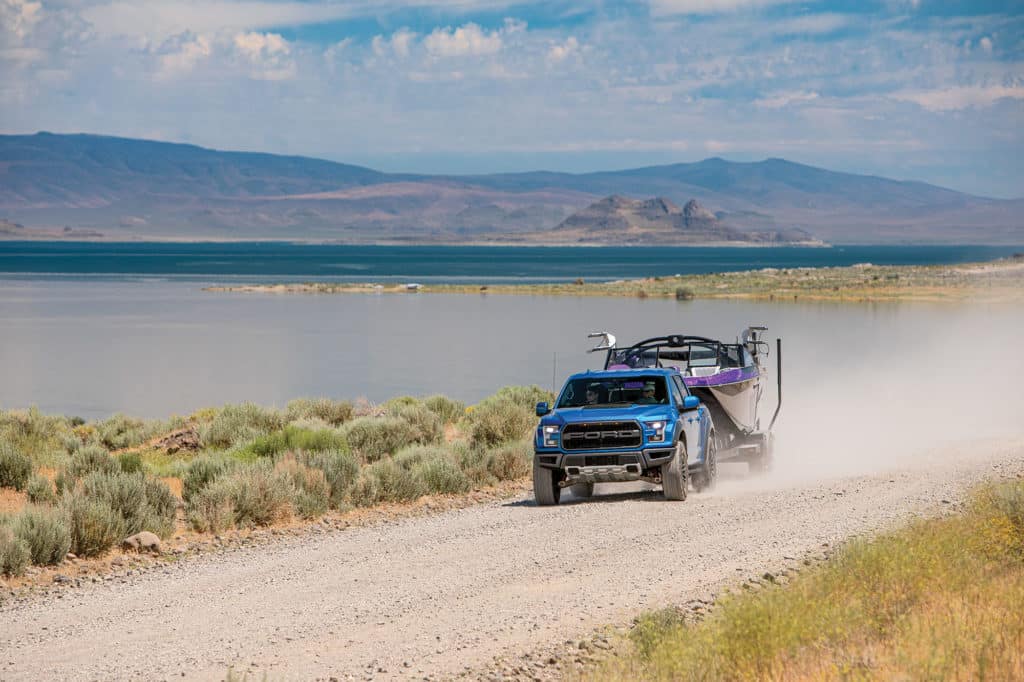
The cost for a day’s boating at Pyramid is as reasonable as you can get—just $13. We skipped the closest launch site, the formal concrete ramp at Pelican Point, and headed north along the perimeter road, searching for solitude. And we soon found it because, in several miles, a gravel washboard jeep track replaced pavement. And while the truck could handle it, decency for the new boat and trailer—despite its four-wheel independent torsion-bar suspension—decried transiting very far along such a road. So we found a broad turnaround and backtracked, eventually vectoring onto a meandering jeep track—and then slowly rounding desert shrubs, ruts and rocks—to find Warrior Point, a modest crescent of shoreline reaching like a church spire into the lake, offering both windward and leeward sides.
On the windward shore, visible to a keen eye, were telltale hollows about 5 feet across: truck and trailer tracks pressed into the desert soil. Following them on foot brought us to the lakeshore, where previous boaters had created a rudimentary underwater support network of flat rocks. We decided to give launching here a try.
Except for one small problem: The Boatmate wouldn’t back up. As mentioned, the trailer features four-wheel hydraulic surge brakes. When the truck’s brakes are applied while driving, the mass of the boat and trailer continue forward, activating a master cylinder in the trailer-brake actuator to apply stopping power. This simple, effective and well-proven system requires no electrical connection to the truck to activate the brakes. However, backing up the trailer on flat, uphill or uneven surfaces can also activate the trailer-brake actuator, literally locking the trailer in place.
That’s why trailers with surge-activated disc brakes come with a fifth blue wire in the trailer pigtail/plug. When fed 12 volts by the vehicle’s reverse-light circuit, this wire energizes a solenoid that locks out the disc brakes so you can back up. However, a trailer’s electrical plugs with the fifth wire require a special adapter to plug into the F-150, and we failed to get one for this trip.
Fortunately, there’s another solution. Such surge-brake trailers also come with a simple lockout clip that can mechanically disable the disc brakes. Unfortunately, we did not have one of those either. But remember that .45 case? One of our crew had saved it, and now, jury-rigged into place with tape, it substituted for the factory lockout clip, permitting backing the boat across the bouncy terrain toward the lake.
Getting in Deep
Engineered boat ramps are great inventions for several good reasons: 1) They’re steep and get boats to floating depth in as short a distance as practical, which means less of your truck needs submerging; 2) their concrete surface (usually) has a nonslip texture to idealize tire grip and keep rigs from miring; and 3) when possible, they’re built in an area with natural protections from wind, waves and current.
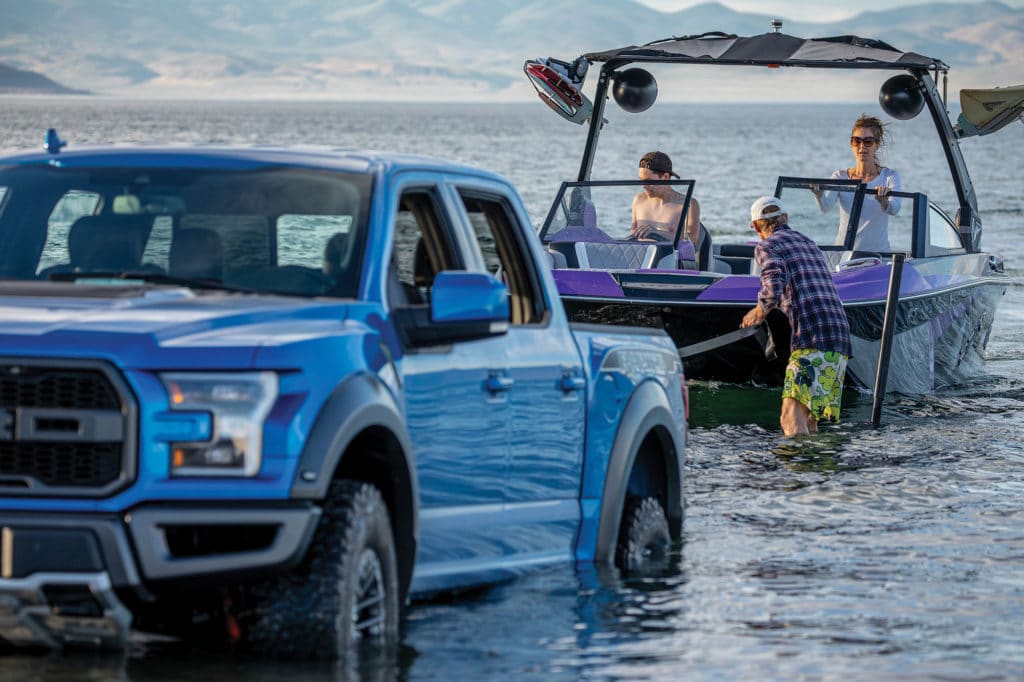
Warrior Point had none of these, and as we set out to try our inaugural Raptor-Tigé immersion on a natural lakeshore, I developed a strategy to not lose nearly $200,000 worth of truck ($72,785 as tested), boat and trailer ($126,754 as tested), thereby becoming the wrong kind of YouTube sensation. And it went like this: Position two teens in the water at the rear corners of the boat trailer, helping me back in straight and watching for any sudden listing of the boat or trailer that would indicate an underwater drop-off. The third teen, stationed adjacent to the truck’s rear wheels, would watch for burying or digging-in of the drive wheels, and the water level at the rear doors.
The primordial ooze of the lakeshore and the shallow bottom contours were nerve-racking because they meant significant risk of sinking the truck while also requiring backing way into the lake to allow the Tigé to float free. As such, I adopted a final strategy for a safe launch (and retrieval): Reverse 3 feet; spotters check for sinking; pull forward 3 feet in 4×4 Low to test retrieval capability; and then reverse 6 feet. By intent, then, each short trial successfully backed boat, trailer and truck 3 feet farther into the lake until, numerous cycles later, the Tigé floated free. Blower on, engine started and gearbox in reverse, the Tigé RZX20 backed serenely into the chalky blue—and still beautifully deserted—Pyramid Lake.
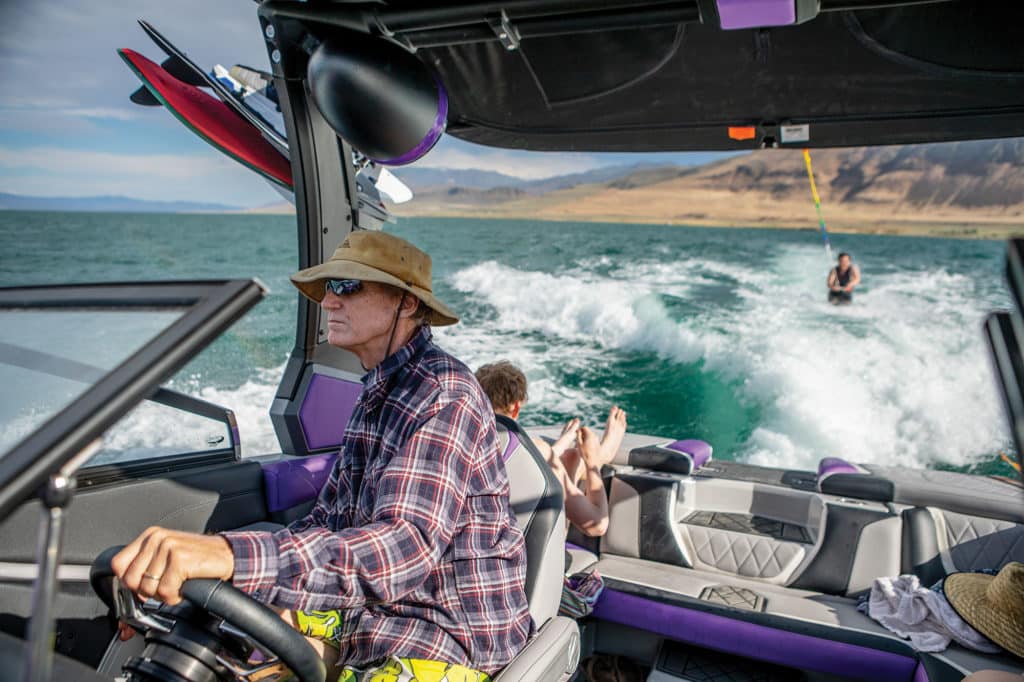
Soon after launching the Tigé, we immediately dived into the wake functions on the big 11-inch touchscreen. These consist of a Surf setting that lowers a center plate at the stern to pull down the rear of the boat, increasing wake height; the TAPS (Tigé Adjustable Performance System) 3 SurfSystem, which operates a combination of port, starboard or center plates to pull one corner of the boat down farther while also yawing the craft; and five ballast tanks, which can hold up to 3,000 pounds of water when full. Experimenting with different presets and then doing our own tailoring for rider, water conditions and passenger count gave us a pretty clean wake of about 2 feet high. Riding perhaps 4 to 8 feet behind the swim platform, it was a nice experience thanks to the best sound system I’ve heard on any vehicle and the quiet underwater tailpipe that Tigé calls “fresh air exhaust.” And the boat’s Raptor engine pulled riders up almost instantly, making it more fun for experts and easier for beginners. The 10.8 mph computer-controlled surf speed was a godsend because keeping a boat exactly between displacement and planing attitudes can be extremely challenging, even with a practiced throttle hand. But the computer did a fine job of it. Well done, Tigé.
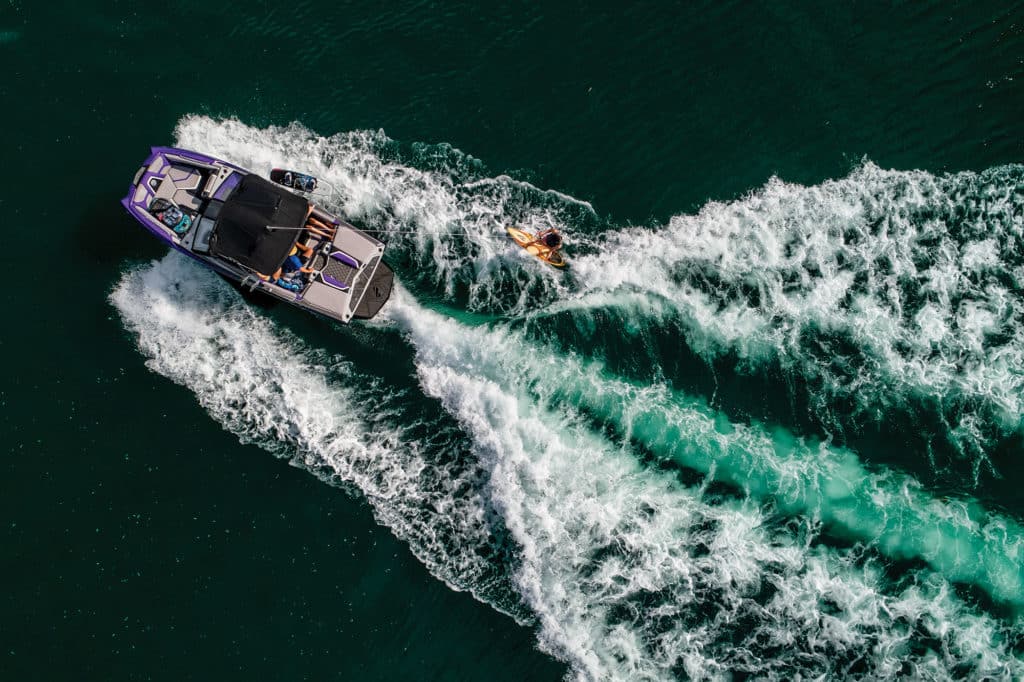
Even at Pyramid’s 3,800-foot elevation, the normally aspirated Indmar V-8 had tons of acceleration for pulling up wakeboarders and surfers. We got riders up in just a few heartbeats. Other niceties included the aforementioned B&O Wet Sounds audio system, which is rider-adjustable on a swim-platform control panel, tunable LED interior lighting, a rear-facing camera, touchscreen controls for virtually every system on the boat including GPS navigation, presets for wakesurfing, wakeboarding and skiing, a large storable Bimini, Tigé’s Alpha E2 powered tower that pivots forward for towing or garaging, and a huge 85.8 cubic feet of storage. We surfed all day until the wind kicked up and we ran out of calm water to set a course.
The Load-Out
As experienced boaters know, winds can be both friendly and finicky, predictable and pernicious—sometimes all on the same day. In true “wind west” style, in the hour or so it took to retrieve the 4,975-pound Tigé, offload our gear, wipe Pyramid’s calcium-rich water off the boat and trailer, tighten the ratcheting transom tie-downs and prep for departure, we noticed yet another change in the winds. Only this time, they were abating instead of blasting. As the sun tracked, degree by degree, toward the 7,000-foot Virginia Mountains, we watched in amazement as Pyramid began settling. The distant lightning vanished, whitecaps gradually ceased, the ruffled surface smoothened, and then, just before sunset, what had been a cauldron of chaos returned to silky blue glass. We could scarcely believe it.
Read Next: Colorado River Boating Adventure!
And yes, we seriously discussed taping that .45 case back in place on the trailer and backing along our proven jeep track right back into the lake for this unexpected evening serenity. But it’d been a long day already, including many hours since lunch. While there are few things better than evening glass, from the teenagers’ perspectives, an In-N-Out Burger in Reno called even louder than my appeal to stay.
“You already got your solitude,” they chorused. “Now we want food!” And that’s the way it goes sometimes when you’re in the Wild West.
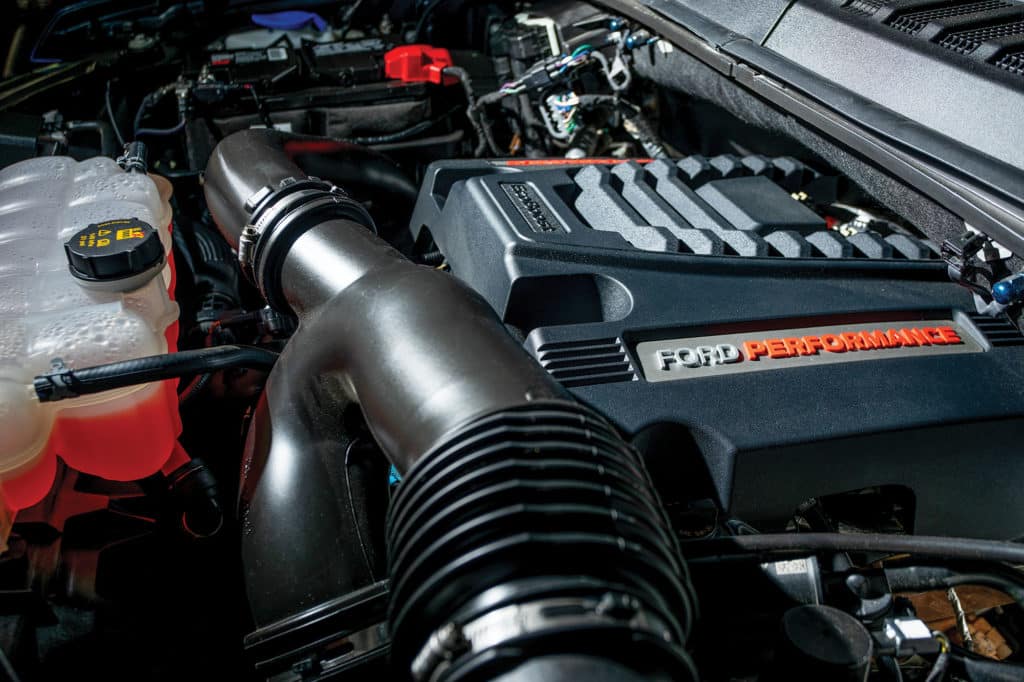
Raptor Power
The Ford F-150 Raptor and Tigé RZX20 both carry Raptor powerplants. Aside from their Ford engineering roots and the Raptor name, though, they’re significantly different animals.
Ford’s turbocharged EcoBoost V-6 truck engine replaced the original 2010-14 SVT Raptor’s normally aspirated V-8 several years ago, to improve fuel economy and emissions without sacrificing performance. The twin-turbo setup builds boost faster than a single large turbo, and helps ensure the powerband matches that of a grunty V-8. The engine is flexible, working well in a variety of conditions, from rock-crawling in 4×4 Low to city traffic to rushing down the interstate and, naturally, towing and launching.
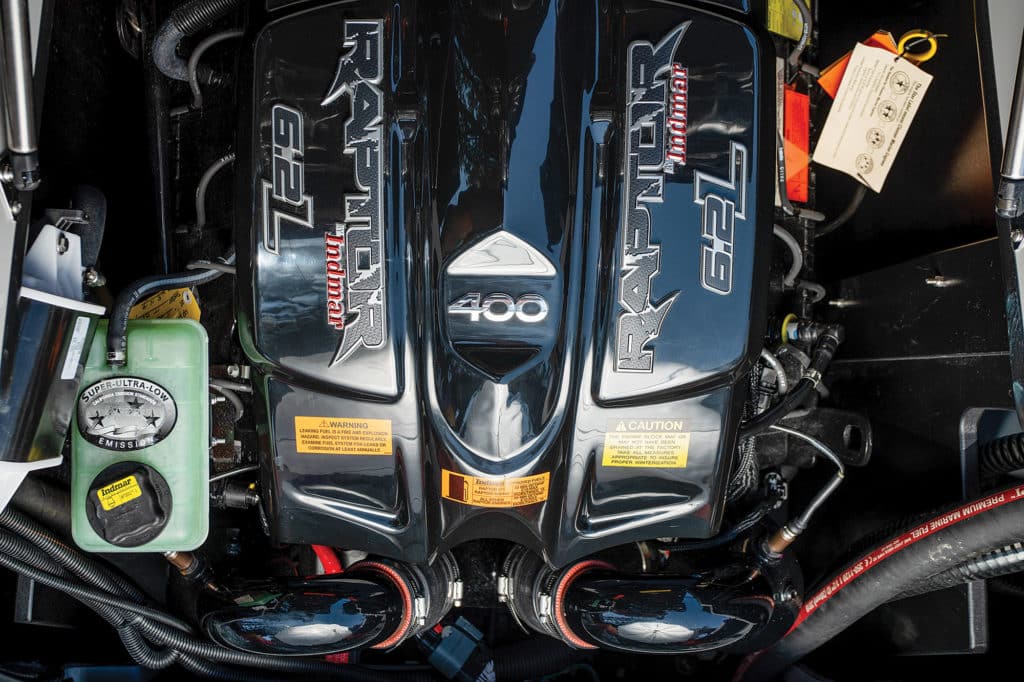
Decidedly understressed compared to the Raptor’s truck engine, Indmar’s 6.2-liter marine V-8 is designed to pull hard literally from idle—and then run, and run, and run some more at fairly constant speeds. Using Ford’s Super Duty truck block, the Indmar metamorphosis to a Raptor marine engine includes tuning to deliver peak torque from 2,500 to 3,500 rpm—ideal for sportboat duty—and a deep-scavenging oil pickup to maintain oil pressure during extreme hull attitudes.
Here’s the numeric lowdown on the Raptor siblings.









